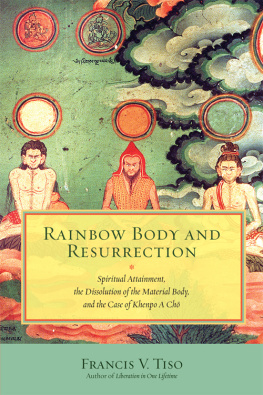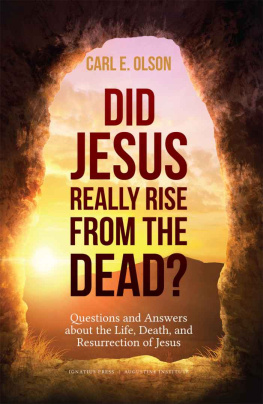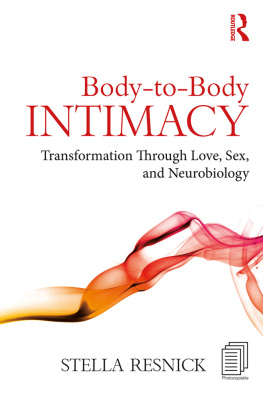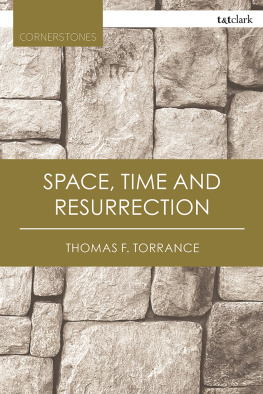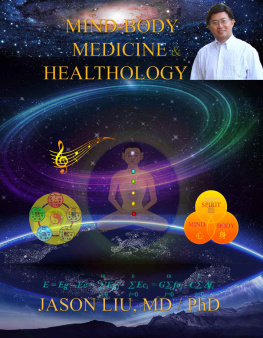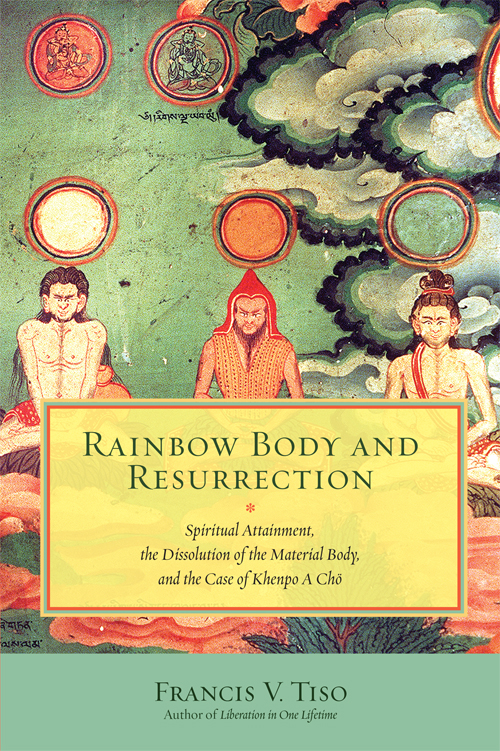
Praise for Rainbow Body and Resurrection

Francis Tiso has written an astonishing work of broad and deep scholarship that blends a personal spiritual journey, erudition, and on-the-ground interviews with witnesses of the rainbow body to reveal a conversation that began long ago in Central Asia about postmortem transformations of the body in a variety of religious traditions. He has delved deeply into esoteric texts and carefully reviewed recent scholarship to present a detailed history and explanation of practices leading to the attainment of the rainbow body as well as the doctrine of the resurrection in Christianity. General readers and scholars alike will find much of interest in [this book].
S ERINITY Y OUNG, P H D, professor, Queens College, research associate, American Museum of Natural History, author of Body & Spirit: Tibetan Medical Paintings
The right medicine for people who forgot how they used to wonder about the afterlife. Stories about this and other boundary crossings are found here and told well. Many will learn to welcome the authors discomforting approach to normalizing the paranormal, and his bold yet entertainable historical claims linking Tibetan Dzogchen with Central Asian Christianity.
D AN M ARTIN , Hebrew University of Jerusalem
I have read with great pleasure Tisos magnificent work and have truly appreciated his reading and interpretation of the Chinese text, Zhixuan anle jing (The Book of Profound Peace and Joy). Here, finally, I am seeing a theological study of the text, which makes me very happy. I greatly appreciate your contextualization of this text in its grounding in the theology and spirituality of the Syriac Church of the East. I would like to thank Tiso very much for having pioneered this fascinating and difficult work of interpretation.
M ATTEO N ICOLINI- Z ANI , monk of Bose
R AINBOW B ODY AND R ESURRECTION

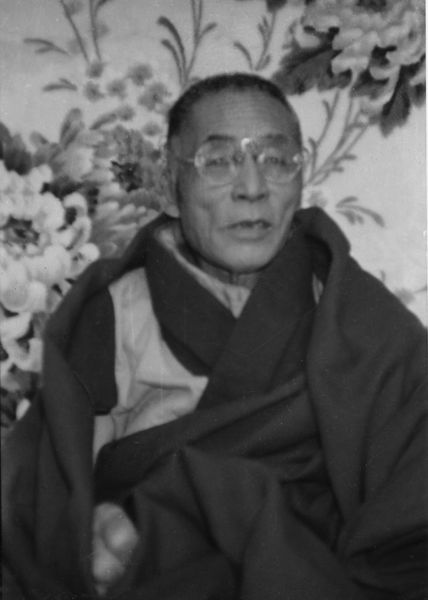
Portrait of Khenpo A Ch
R AINBOW B ODY AND R ESURRECTION
Spiritual Attainment, the Dissolution of the Material Body, and the Case of Khenpo A Ch
F RANCIS V . T ISO

North Atlantic Books
Berkeley, California
Copyright 2016 by Francis V. Tiso. All rights reserved. No portion of this book, except for brief review, may be reproduced, stored in a retrieval system, or transmitted in any form or by any meanselectronic, mechanical, photocopying, recording, or otherwisewithout the written permission of the publisher. For information contact North Atlantic Books.
Published by
North Atlantic Books
Berkeley, California
Cover photo of kLu Khang mural used by permission of David Germano
Cover design by Nicole Hayward
About the cover: This photo is of a portion of a mural at kLu Khang (Serpent Deity Temple), also known as the Dalai Lamas secret temple, probably built in the 1680s, in Lhasa, Tibet.
Rainbow Body and Resurrection: Spiritual Attainment, the Dissolution of the Material Body, and the Case of Khenpo A Ch is sponsored and published by the Society for the Study of Native Arts and Sciences (dba North Atlantic Books), an educational nonprofit based in Berkeley, California, that collaborates with partners to develop cross-cultural perspectives, nurture holistic views of art, science, the humanities, and healing, and seed personal and global transformation by publishing work on the relationship of body, spirit, and nature.
North Atlantic Books publications are available through most bookstores. For further information, visit our website at www.northatlanticbooks.com or call 800-733-3000.
Library of Congress Cataloging-in-Publication Data
Tiso, Francis, author.
Rainbow body and resurrection : spiritual attainment, the dissolution of the material body, and the case of Khenpo A Cho / Francis V. Tiso.
pages cm
Summary: Francis V. Tiso, a noted authority on the rainbow body, explores this manifestation of spiritual realization in a wide-ranging and deeply informed study of the transformation of the material body into a body of light. The result is an illuminating consideration of previously unimagined relationships between spiritual practices and beliefs in Central AsiaProvided by publisher.
ISBN 978-1-58394-795-1 (paperback)ISBN 978-1-58394-796-8 (ebook)
1. Rdzogs-chen. 2. Resurrection. 3. Mkhan-po-a-chos, 1918-1998. 4. SpiritualityAsia, CentralHistory. I. Title.
BQ7662.2.T58 2016
294.3423dc23
2015013194
Then the Day of the Lord, like a thief, will come, and the heavens will disappear with a great explosion; the elements will be consumed by the heat and dissolve. The world with all its actions will be destroyed.
II P ETER 3:10
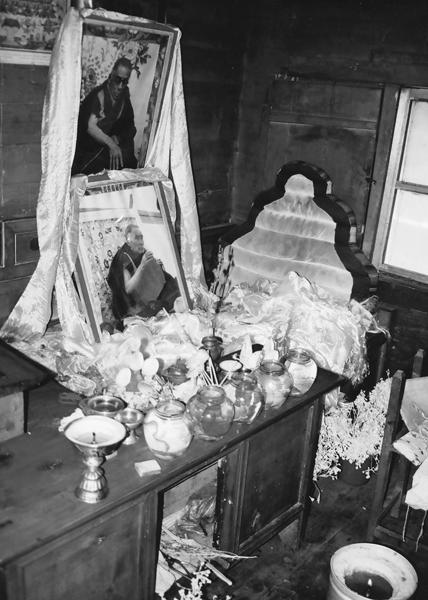
Inside Khenpo A Chs hermitage: his personal shrine.
C ONTENTS


The Rainbow Body: Finding a Method
I n Italian we have a slightly cynical expression used to inquire about someone we havent heard from in a while: Che fin ha fatto? Literally this means: What end did he come to? As if to ask, did he die and did his death vindicate his hopes? Or did it rather confirm our doubts? Did someone make good, or was he a flop? We might translate it: Whatever became of so and so? In the case of Christ, we could imagine the folks of Nazareth asking such a question and after being told about the crucifixion, responding: We told you so!
The cynicism of the village lives on in many of our verbal expressions and even in the methods by which we think we are establishing scientific truth. Historian John Lukacs observes that science is, after all, a product of scientists and is therefore a cultural product or even mirabile dictu, a fashion of the times.explanation for phenomena that in fact cannot be explained. Moreover, the explanations offered amount to analogies that accord with the mentality of the literate public at any given point in history. This is the real meaning of paradigm shifts in the history of science.
In 1913, the French physicist and historian of science, Pierre Duhem, wrote: The study of the method of physics is powerless to disclose to the physicist the reason leading him to construct a physical theory. The scientist is as dependent on accepted and acceptable ideas within the general climate of opinion of his or her times as anyone else; unfortunately, science is embedded in larger tendencies of thought and their power. As a consequence, science is really not automatically self-correcting and can indeed be led astray. One of the ways by which science, i.e., scientists, can be led astray is when a particular analogy becomes predominant to the extent that theorists forget the reasons they were motivated to construct a new paradigm. Often these reasons are cultural and even

